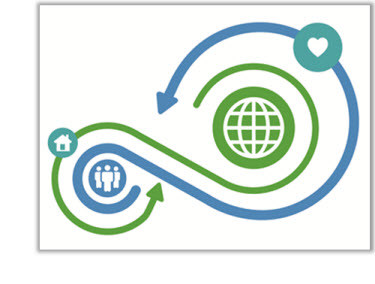Guest post by Catherine Reeves, Manager, EHS&S Communications, Xerox Corporation
Sustainability is about improving the quality and economics of our lives without degrading the environment at the same time. Tree planting is often used as an example to demonstrate sustainability. While trees are essential to the ecosystem, relegating sustainability to such an example trivializes the depth and breadth of the term.
If we are to make a measurable difference, then we have to look at our everyday processes at home and at work and understand what makes them run, how they run, and the end results. Sounds so basic, doesn’t it? The truth is that most of us are programmed to do things the way we always have, or we just don’t have the time to think of how to change for the better. Another reason might be that we think our change will not make a difference or just screw everything up. This is true of individuals at home and at work; and of companies, whatever their business and regardless of geographical location.
The reasons for not taking action to be more sustainable are all very understandable. Some may ask, “Where do I begin?” To that question, I offer a simple answer: by looking at the sustainability profile of the business BEFORE you make a purchase. Three things will indicate if the company has a preferable sustainability profile:
Sustainability History – Is the company you are considering doing business with new to the game or do they have a history of sustainability? One that has created sustainability history will have learned many lessons that they have factored into their business today. It also demonstrates that they have a lasting commitment and do not regard sustainability as a flavor of the times to lure buyers.
Innovative Value – Has the company “invented” or developed a product or solution having sustainability value? Research and Development is a costly proposition for any company today. By purchasing from the company that invented the product, that has sustainability value, you may indirectly invest in their ongoing R+D effort that will yield more innovative and sustainable products in the future.
Hold Their Suppliers to the same High Sustainability Standards – Every company has suppliers of some sort. Since we are all connected by the concept of an “environmental footprint,” our suppliers environmental footprint become part of our environmental footprint. If you want your home, business and/or company to practice sustainability, then begin by looking upstream and choosing your suppliers carefully. That saying of “Birds of a feather fly together” creates a good visual. A company that has a sustainability history is not going to select a supplier that does not and who may tarnish their brand they have worked so hard and long to establish. They will consciously select a supplier that has the same regard for sustainability. How do you as a buyer know if your supplier meets this criteria? There are a few ways. Go to the company website and type “sustainability” in the search window. Does the supplier publish a Corporate Social Responsibility [CSR] Report that may also be called “Sustainability Report”? Do they mention the sustainability standards they hold their suppliers to? Is the company a member of UN Global Compact or Electronics Industry Citizenship Coalition [EICC]? These are examples of two non-governmental organizations whose members [companies] exist to drive sustainability across a company’s value chain and supplier base. Companies voluntarily sign the charter and require their suppliers to do the same.
Lastly, a company that meets these three criteria is going to be proud. The landing page of their website and other social media will most likely reference their sustainability history, accomplishments and corporate citizenship.
It’s truly amazing that our collective and careful selection of goods, services and suppliers can make a difference. Imagine what’s possible if all individuals, companies whether small, medium or large, and organizations globally select suppliers that have the preferable sustainability profile. The power of numbers would be in full play. Any individual or purchasing entity, has leverage because of their purchasing power, especially in these constrained economic times. The fate of sustainability in the hands of the buyer.



[…] The Fate of Sustainability – It’s in the Hands of the Buyer […]